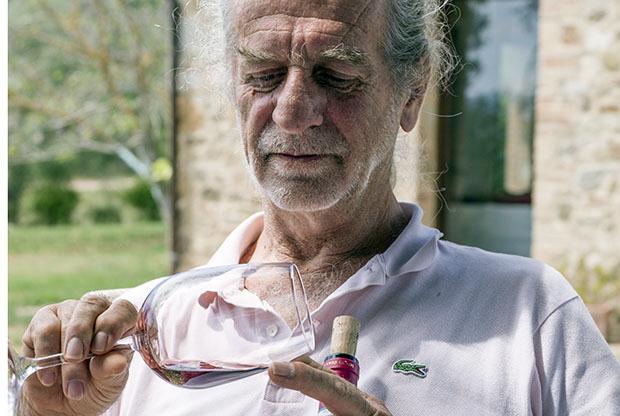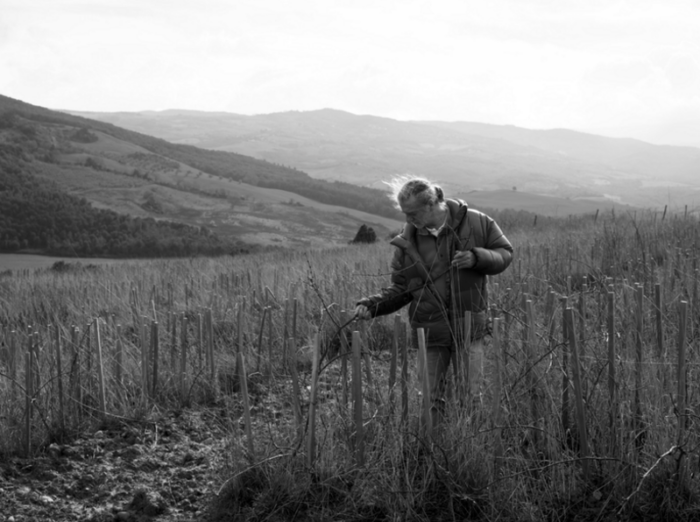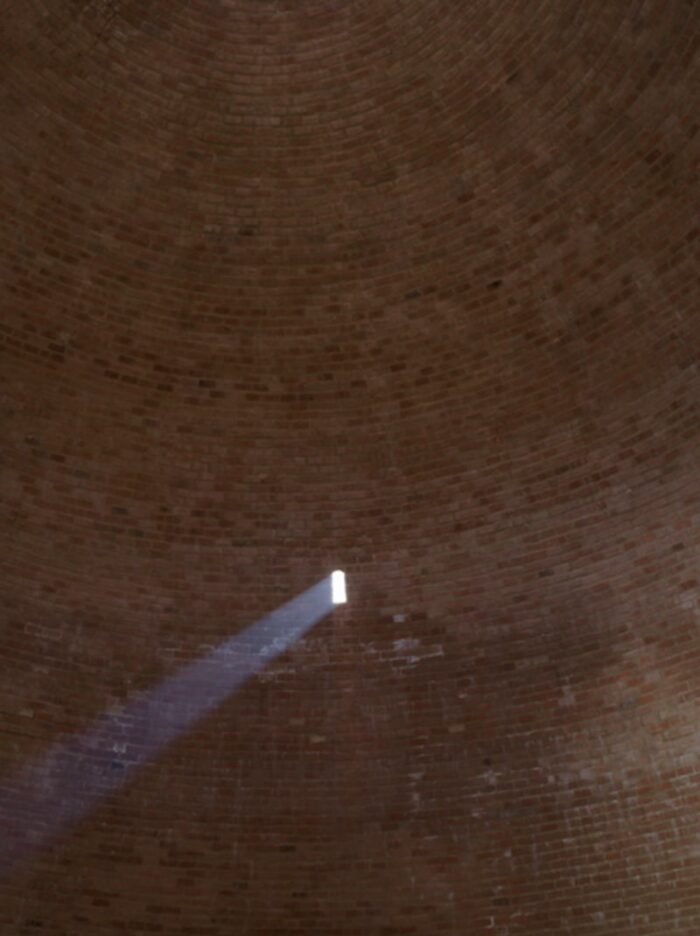Book your visit
02/05/2016
“Wait!” It is 5pm on a crisp February afternoon. The light is fading fast but before we go and look at the vineyard, Francesco Illy needs to drink an espresso.

“It will only take 15 seconds.” We follow the shaggy grandson of the Francesco Illy who in 1933 founded Illy caffé, into the kitchen of his Tuscan house and watch as he selects one of a battery of five different machines – “Yes, I use them all but this one’s faster.”
We’re in Montalcino in the week of the release of the 2011 Brunellos, and Illy has just held the official opening of his new cellar. It’s a beautiful snail-shell-like construction that was made by laying 750,000 bricks, echoes the Pantheon in Rome and uses the proportions of the golden mean, a ratio that dates back at least to Pythagoras and is believed to underpin the structure both of ferns and financial markets.
The Trieste-raised Italian, who now works for the family business in Switzerland, bought the Podere le Ripi estate here in 1998. From the building of the cellar to the planting of the vines, he has been doing things differently from the locals ever since. And the story of how he came to be here is unusual, too.

“It seems like I was born with a weak liver so when I was 18, the doctor said, ‘You must drink some spa water’. I was going to Boio, which is a pretty ugly place, then he sent me near here.” So let’s get this straight: man with weak liver comes to Tuscany for a cure, and decides to make wine?
“Oh, I wasn’t worried about my liver, and it didn’t happen like that. I love nature and I fell in love with Tuscany and made friends.” He kept returning, and eventually decided he wanted a house of his own. The search for a podere [a country estate with a farmhouse] eventually led him here, to the south of the hilltop village of Montalcino where, next to the Mastrojanni wine estate, he found 54 hectares of land, not a single vine, a house, and a Sardinian shepherd asleep under an oak tree.
Once here it seemed ridiculous not to plant vines, so he did, but with the express intention of selling the grapes to other producers. “I thought I was too old to learn how to make wine.” But not doing things properly is not really the Illy style. “Francesco often says we will do something, and it seems impossible to me, but six or 12 months later I find it’s happening,” says his bright young oenologist, Sebastian Nasello.

In 2003, a super-hot year throughout Europe, when many of his grapes were so raisined as to be unsaleable, Illy decided to have a bash at vinifying them himself, producing a small quantity – just two barrels – of “extremely good” sweet wine. “This kind of made me a winemaker, because the attraction was very strong to the vertical experience of preparing the soil, growing the grapes, making and then finally drinking the wine. It brings you into a rapport with the land.”
That was the turning point, but Illy had already been very hands-on with the viticulture. Planting vines at higher density (in terms of the number of plants per hectare) is already fashionable among producers of higher quality wine. Illy got the idea from a visit to Burgundy where he was told he’d have to wait 35 years before the vines produced decent wine. “I asked myself, shall I wait until I’m 90?” and began to increase the density of his own plantings. “It obliges the roots to go deeper, more quickly, which means they get the benefit of the minerals in different geological layers.”
Of course he took the concept of planting at higher density further than anyone else. At Podere le Ripi there are a few small areas planted with a crazy 62,500 vines per hectare. No one in the world has planted so many vines so close together – Illy took out an advertisement in The Wine Spectator, challenging anyone who had to speak up. He calls them his bonsai vines. The vineyard workers hate them and are desperate to pull them out. Who wants to look after vines planted so close you have to contort yourself to prune and treat? But Illy is adamant – and the bonsai vines are used to make his most expensive wine.
Illy is a highly energised, visionary, tree-loving hippy at heart. He works according to the principles of biodynamics – think organic, but also take into account the movements of the celestial bodies.
“I wanted to do everything organically because it doesn’t put any poison in the soil – or in you. Also, biodynamics creates jobs because it is more labour intensive. It also sequestrates about four tons a year of carbon dioxide, whereas conventional farming puts about the same amount back into the atmosphere.” Is he so ecologically-minded in the rest of his life? I ask, as we sit in his gigantic car outside the agriturismo where I am staying. “I try to be, except the car, I live in this, many hours. But I have also planted 10,000 trees in Egypt.”
The design of the new cellar was inspired by Illy’s desire to make and mature wine in completely harmonious surroundings. A visit to the crypt underneath the Chiesa del Gesù in nearby Montepulciano provided the inspiration for an inner dome, which echoes the Pantheon, and whose acoustics are able to magnify a feeble whisper to a resonant proclamation. Illy designed it with the help of his architect-trained son Ernesto (who also works for the family coffee firm) but it was the original architect who worked on the project who suggested utilising the golden mean. “You can find this concept in many, many things – in Stonehenge and the Pyramids, old Roman and Greek construction.”
The cellar also has a built-in sundial – a hole through which a shaft of light will fall every day when the sun is at its zenith. On average it means that sun will strike stone at noon and 13 minutes and 14 seconds. It is built in continuous descent – there are almost no flat floors until you reach the bottom, just a gently descending spiral passageway. A further peculiarity is that Illy was insistent that the construction contain no steel girders or metal bottle-storage cases, on the grounds that, “metal creates a Faraday cage and this creates very weak electricity and a very weak magnetic field. I asked a doctor if doing this” – he touches a leg very gently with his fingertip – “continuously for five years would hurt and he said, ‘Well it’s going to give you an injury.’ It’s the same with the wine.”
Illy is ambitious for his wines. At her own estate, his girlfriend, Stella di Campalto, makes some of the best in Montalcino but his wine role models are further afield: he cites Guigal from the Rhône and talks a lot about Vega Sicilia, the Spanish icon from Ribera del Duero. Now those are big wines: Vega Sicilia’s Unico sees a lot of oak and long ageing before its release. Illy says that he wants to release his wines ever later, and certainly later than is traditional in Montalcino, where Brunello is released more than four years after the harvest.

The Podere le Ripi wines are big and warm with soft tannins and high alcohol. My least favourite was the most expensive: the Bonsai (the 2010 retails at £130 a bottle). It smells of russet leaves and fruits and overwhelmingly of oak spice; the Vega Sicilia influence is certainly evident here, in the concentration and also the flavour. The strong, bear-hug flavours have wiped out some of the beautiful sangiovese texture, though it’s still a satisfying drink, rather like a blood transfusion.
The price of all the wines is also ambitious, and my favourite was the most lowly (around £30.95), made with local grapes: the Amore e Magia Rosso di Montalcino from the stellar 2010 vintage. It is a Brunello in all but name: “We age it like a Brunello,” says Sebastian Nasello. The 2010 is big, warm and comforting, with explosive flavours. The 2011 that will follow is sweeter, warmer and stronger (15%).
“There’s nothing like being responsible for a finished product that puts a smile on your face while you drink it,” says Illy. “I remember the first time I saw someone enjoying my wine in a restaurant – they had such a satisfied expression. I will never forget it.”
Credits: The Telegraph LuxuryArticle by: Victoria MoorePictures: Andy Sewell